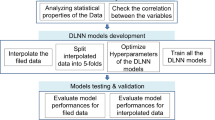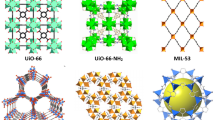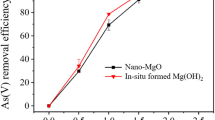Abstract
Globally, millions of rural households that use groundwater for drinking are exposed to inorganic arsenic, frequently as arsenite (As(III)). Crucial for health protection, adsorption-based treatment works well for arsenate (As(V)) but not for slower-adsorbing As(III). Liquid oxidants, though impractical for point of use, are widely used to pre-oxidize As(III) to As(V) in point-of-entry treatment for better performance and cost saving. Here MnO2-modified activated carbon, a solid oxidant, was integrated into a point-of-use system with granular nano-TiO2 as the main adsorbent for two real-world tests, supplying As-safe water at less than US$0.01 l−1. One 4-month deployment treated 4,200 bed volumes (~2.1 m3) of groundwater with 69 ± 16 μg l−1 As (78 ± 5% As(III)). Another 28-month deployment treated 10,000 bed volumes (~5.0 m3) of groundwater with 42 ± 21 μg l−1 As (33 ± 21% As(III)). Interactions between the groundwater matrix and filter media affect performance, highlighting the need to verify household As removal technologies through long-term deployments.
This is a preview of subscription content, access via your institution
Access options
Subscribe to this journal
Receive 12 digital issues and online access to articles
118,99 € per year
only 9,92 € per issue
Buy this article
- Purchase on SpringerLink
- Instant access to full article PDF
Prices may be subject to local taxes which are calculated during checkout




Similar content being viewed by others
Data availability
Data for all the aqueous-phase and solid-phase samples mentioned in this article are provided in Supplementary Tables 3–9. Relative abundance of Fe-, Mn-, S- and N-related bacterial community for the solid samples after 28-month deployment at YC is provided in Supplementary Table 10, with the sequence data available in NCBI under accession number PRJNA1013411.
References
Zheng, Y. et al. Redox control of arsenic mobilization in Bangladesh groundwater. Appl. Geochem. 19, 201–214 (2004).
Ravenscroft, P., Brammer, H. & Richards, K. Arsenic Pollution: A Global Synthesis (Wiley-Blackwell, 2009).
Guidelines for Drinking-Water Quality: Fourth Edition Incorporating the First Addendum (World Health Organization, 2017).
Smith, A. H. et al. Cancer risks from arsenic in drinking-water. Environ. Health Perspect. 97, 259–267 (1992).
Chen, Y. et al. Arsenic exposure from drinking water and mortality from cardiovascular disease in Bangladesh: prospective cohort study. Br. Med. J. 342, d2431 (2011).
Podgorski, J. & Berg, M. Global threat of arsenic in groundwater. Science 368, 845–850 (2020).
Daniel, D., Marks, S. J., Pande, S. & Rietveld, L. Socio-environmental drivers of sustainable adoption of household water treatment in developing countries. NPJ Clean Water https://doi.org/10.1038/s41545-018-0012-z (2018).
Johnston, R. B., Hanchett, S. & Khan, M. H. The socio-economics of arsenic removal. Nat. Geosci. 3, 2–3 (2010).
Yang, Q. et al. Reduction in drinking water arsenic exposure and health risk through arsenic treatment among private well households in Maine and New Jersey, USA. Sci. Total Environ. 738, 139683 (2020).
Petrusevski, B., Sharma, S. K., Kruis, F., Omeruglu, P. & Schippers, J. C. Family filter with iron-coated sand: solution for arsenic removal in rural areas. Water Supply 2, 127–133 (2002).
Spayd, S. Arsenic Water Treatment for Private Wells in New Jersey. New Jersey Geological and Water Survey, Information Circular https://www.nj.gov/dep/njgs/enviroed/infocirc/ArsenicMainICv1.pdf (2023).
Spayd, S. Arsenic Water Treatment for Residential Wells in New Jersey. New Jersey Geological Survey, Information Circular https://www.nj.gov/dep/pwta/Arsenic_Treatment.pdf (2007).
Mahanta, R., Chowdhury, J. & Nath, H. K. Health costs of arsenic contamination of drinking water in Assam, India. Econ. Anal. Policy 49, 30–42 (2016).
Roy, J. Economic benefits of arsenic removal from ground water—a case study from West Bengal, India. Sci. Total Environ. 397, 1–12 (2008).
Walker, M., Seiler, R. L. & Meinert, M. Effectiveness of household reverse-osmosis systems in a Western US region with high arsenic in groundwater. Sci. Total Environ. 389, 245–252 (2008).
Zheng, Y. Lessons learned from arsenic mitigation among private well households. Curr. Environ. Health Rep. 4, 373–382 (2017).
Westerhoff, P. K., Benn, T. M., Chen, A., Wang, L. & Cumming, L. J. Assessing Arsenic Removal by Metal (Hydr)oxide Adsorptive Media Using Rapid Small Scale Column Tests Report No. EPA/600/R-08/051US (US Environmental Protection Agency, 2008).
Bang, S. et al. Removal of arsenate from water by adsorbents: a comparative case study. Environ. Geochem. Health 33, 133–141 (2011).
Siegel, M. et al. Pilot Test of Arsenic Adsorptive Media Treatment Technologies at Socorro Springs, New Mexico. Materials Characterization and Phase I Results. Sandia Report SAND2007-0161. Sandia National Laboratories https://citeseerx.ist.psu.edu/document?repid=rep1&type=pdf&doi=74f9472fdce70ccfc9751745c1724d18d311d177 (2007).
Westerhoff, P., De Haan, M., Martindale, A. & Badruzzaman, M. Arsenic adsorptive media technology selection strategies. Water Qual. Res. J. Can. 41, 171–184 (2006).
Dou, X. et al. Occurrence of arsenic in groundwater in the suburbs of Beijing and its removal using an iron-cerium bimetal oxide adsorbent. Water Qual. Res. J. Can. 41, 140–146 (2006).
Cui, J., Du, J., Yu, S., Jing, C. & Chan, T. Groundwater arsenic removal using granular TiO2: integrated laboratory and field study. Environ. Sci. Pollut. Res. 22, 8224–8234 (2015).
Bang, S., Patel, M., Lippincott, L. & Meng, X. G. Removal of arsenic from groundwater by granular titanium dioxide adsorbent. Chemosphere 60, 389–397 (2005).
Pena, M. E., Korfiatis, G. P., Patel, M., Lippincott, L. & Meng, X. G. Adsorption of As(V) and As(III) by nanocrystalline titanium dioxide. Water Res. 39, 2327–2337 (2005).
Jing, C., Meng, X., Calvache, E. & Jiang, G. Remediation of organic and inorganic arsenic contaminated groundwater using a nanocrystalline TiO2-based adsorbent. Environ. Pollut. 157, 2514–2519 (2009).
Hu, S., Shi, Q. & Jing, C. Groundwater arsenic adsorption on granular TiO2: integrating atomic structure, filtration, and health impact. Environ. Sci. Technol. 49, 9707–9713 (2015).
Manning, B. A., Fendorf, S. E., Bostick, B. & Suarez, D. L. Arsenic(III) oxidation and arsenic(V) adsorption reactions on synthetic birnessite. Environ. Sci. Technol. 36, 976–981 (2002).
Zhang, W. et al. Efficient oxidation and sorption of arsenite using a novel titanium(IV)–manganese(IV) binary oxide sorbent. J. Hazard. Mater. 353, 410–420 (2018).
Wang, Y. et al. Simultaneous removal and oxidation of arsenic from water by δ-MnO2 modified activated carbon. J. Environ. Sci. 94, 147–160 (2020).
Zhang, W. et al. Enhanced removal of arsenite and arsenate by a multifunctional Fe–Ti–Mn composite oxide: photooxidation, oxidation and adsorption. Water Res. 147, 264–275 (2018).
Zhang, G., Qu, J., Liu, H., Liu, R. & Wu, R. Preparation and evaluation of a novel Fe–Mn binary oxide adsorbent for effective arsenite removal. Water Res. 41, 1921–1928 (2007).
Shan, C. & Tong, M. Efficient removal of trace arsenite through oxidation and adsorption by magnetic nanoparticles modified with Fe–Mn binary oxide. Water Res. 47, 3411–3421 (2013).
Möller, T., Sylvester, P., Shepard, D. & Morassi, E. Arsenic in groundwater in New England—point-of-entry and point-of-use treatment of private wells. Desalination 243, 293–304 (2009).
Pratson, E., Vengosh, A., Dwyer, G., Pratson, L. & Klein, E. The effectiveness of arsenic remediation from groundwater in a private home. Ground Water Monit. Rem. 30, 87–93 (2010).
Thomson, B. M., Cotter, T. J. & Chwirka, J. D. Design and operation of point-of-use treatment system for arsenic removal. J. Environ. Eng. 129, 561–564 (2003).
Barringer, J. L. et al. Sources and temporal dynamics of arsenic in a New Jersey watershed, USA. Sci. Total Environ. 379, 56–74 (2007).
Dixit, S. & Hering, J. G. Comparison of arsenic(V) and arsenic(III) sorption onto iron oxide minerals: implications for arsenic mobility. Environ. Sci. Technol. 37, 4182–4189 (2003).
Hsu, J.-C., Lin, C.-J., Liao, C.-H. & Chen, S.-T. Removal of As(V) and As(III) by reclaimed iron-oxide coated sands. J. Hazard. Mater. 153, 817–826 (2008).
Jegadeesan, G. et al. Arsenic sorption on TiO2 nanoparticles: size and crystallinity effects. Water Res. 44, 965–973 (2010).
Eggerichs, T. et al. Growth of iron-oxidizing bacteria Gallionella ferruginea and Leptothrix cholodnii in oligotrophic environments: Ca, Mg, and C as limiting factors and G. ferruginea necromass as C-source. Geomicrobiol. J. 37, 190–199 (2020).
Cheng, Q., Huang, Y., Nengzi, L. & Zhang, J. Performance and microbial community profiles in pilot-scale biofilter for the simultaneous removal of ammonia, iron and manganese at different manganese concentrations. Bioprocess. Biosyst. Eng. 42, 741–752 (2019).
Mohan, D. & Pittman, C. U. Jr. Arsenic removal from water/wastewater using adsorbents—a critical review. J. Hazard. Mater. 142, 1–53 (2007).
USEPA. Arsenic Treatment Technology Evaluation Handbook for Small Systems (US Environmental Protection Agency, 2003).
Meng, X. G., Bang, S. & Korfiatis, G. P. Effects of silicate, sulfate, and carbonate on arsenic removal by ferric chloride. Water Res. 34, 1255–1261 (2000).
Biswas, A. et al. Role of competing ions in the mobilization of arsenic in groundwater of Bengal Basin: insight from surface complexation modeling. Water Res. 55, 30–39 (2014).
Gao, Y. & Mucci, A. Acid base reactions, phosphate and arsenate complexation, and their competitive adsorption at the surface of goethite in 0.7 M NaCl solution. Geochim. Cosmochim. Acta 65, 2361–2378 (2001).
George, C. M., Smith, A. H., Kalman, D. A. & Steinmaus, C. M. Reverse osmosis filter use and high arsenic levels in private well water. Arch. Environ. Occup. Health 61, 171–175 (2006).
He, Y. et al. A critical review of on-site inorganic arsenic screening methods. J. Environ. Sci. 125, 453–469 (2023).
Meng, X. & Wang, W. Speciation of arsenic by disposable cartridges. In Book of Posters of the Third International Conference on Arsenic Exposure and Health Effects (Society of Environmental Geochemistry and Health, Univ. Colorado, 1998).
Keon, N. E., Swartz, C. H., Brabander, D. J., Harvey, C. F. & Hemond, H. F. Validation of an arsenic sequential extraction method for evaluating mobility in sediments. Environ. Sci. Technol. 35, 2778–2784 (2001).
Yu, Y., Lee, C., Kim, J. & Hwang, S. Group-specific primer and probe sets to detect methanogenic communities using quantitative real-time polymerase chain reaction. Biotechnol. Bioeng. 89, 670–679 (2005).
Callahan, B. J. et al. DADA2: high-resolution sample inference from Illumina amplicon data. Nat. Methods 13, 581–583 (2016).
Quast, C. et al. The SILVA ribosomal RNA gene database project: improved data processing and web-based tools. Nucleic Acids Res. 41, D590–D596 (2013).
Acknowledgements
We thank the Chen family for allowing us to install the household As removal units in Yinchuan Plain. Support was provided by the National Natural Science Foundation of China (grant 41831279, Y.Z.), the National Key R&D Program of China (grant 2021YFA0715900, Y.D.), the Shenzhen Key Laboratory of Precision Measurement and Early Warning Technology for Urban Environmental Health Risks (grant ZDSYS20220606100604008, Y.D. and Y.Z.), the Guangdong Province Bureau of Education (grant 2020KCXTD006, Y.Z.), the Guangdong Provincial Key Laboratory of Soil and Groundwater Pollution Control (grant 2023B1212060002, Y.Z.), the National Natural Science Foundation of China (grant 32250410300, A.P.) and High Level of Special Funds (grant G030290001, Y.Z.)
Author information
Authors and Affiliations
Contributions
Design: X.M and Y.Z. Deployment and sampling: Y.S., Z.L., Q.S., Y.D., Q.Y., X.M. and Y.Z. Methodology: Y.D., Y.S., A.P., B.Y., Q.S., Q.Y. and D.Z.Z. Formal analysis: Y.D., Y.S., A.P. and X.M. Project administration: Y.Z. and X.M. Writing—original draft: Y.D. and Y.Z. Writing—review and editing: Y.D., Y.S., A.P., Z.L., B.L., Q.S., D.Z.Z., Q.Y., X.M. and Y.Z.
Corresponding authors
Ethics declarations
Competing interests
The authors declare no competing interests.
Peer review
Peer review information
Nature Water thanks Mengchang He and the other, anonymous, reviewer(s) for their contribution to the peer review of this work.
Additional information
Publisher’s note Springer Nature remains neutral with regard to jurisdictional claims in published maps and institutional affiliations.
Supplementary information
Supplementary Information
Supplementary Text 1–5, Figs. 1–8 and Tables 1–10.
Source data
Source Data Fig. 1
Source data for bed volumes of treated water and daily water use for each month.
Source Data Fig. 2
Source data for arsenic, iron and manganese in the influent and effluent for the 4-month deployment in NJ and 28-month deployment in YC.
Source Data Fig. 3
Source data for arsenic, iron and manganese of five treatment media samples collected after 28-month deployment in YC.
Source Data Fig. 4
Source data for relative abundance of Fe-, N- and S-related bacterial community for the five solid samples.
Rights and permissions
Springer Nature or its licensor (e.g. a society or other partner) holds exclusive rights to this article under a publishing agreement with the author(s) or other rightsholder(s); author self-archiving of the accepted manuscript version of this article is solely governed by the terms of such publishing agreement and applicable law.
About this article
Cite this article
Duan, Y., Sun, Y., Palomo, A. et al. MnO2-modified activated carbon and granular nano-TiO2 in tandem succeed in treating domestic well water arsenic at point of use. Nat Water 2, 674–683 (2024). https://doi.org/10.1038/s44221-024-00268-9
Received:
Accepted:
Published:
Issue Date:
DOI: https://doi.org/10.1038/s44221-024-00268-9



